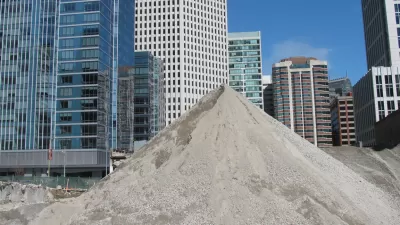No sooner had the $6.4 billion eastern span of the Bay Bridge opened to traffic than the next huge transportation undertaking begun -- concrete began pouring for the new $4.5 billion Transbay Terminal. The bridge and terminal are related by history.
The 1937 Bay Bridge and the 1939 Transbay Terminal were both built to accommodate transbay traffic - one carried private motor vehicles, the other serviced public, electric transit vehicles in the form of streetcars and interurban trains. While the new terminal will not likely see the same traffic it did at the end of World War II when ten car trains arrived every 63.5 seconds, according to the Transit Center's history webpage, it has nevertheless been dubbed the "Grand Central Station of the West coast" by the dignitaries gathered to celebrate the ceremonial concrete pouring on September 5th, including San Francisco Mayor Ed Lee and House Democratic leader, Nancy Pelosi, writes J.K. Dineen.
Transbay Joint Powers Authority Executive Director Maria Ayerdi-Kaplan said workers have come a long way since August 2010 when the project broke ground. The old terminal has been knocked down, with 100 percent of its materials recycled, she said.
The project, designed to be the terminal for both California's embattled High Speed Rail project and the 150-year San Jose to San Francisco commuter line known as Caltrain, as well as many regional bus lines including AC Transit's Transbay routes, will be the centerpiece of a new, 145-acre "transit center district".
The plan for the transit district around the transportation depot includes 4,500 housing units, 30 percent of them affordable, as well as 6 million square feet of office space.
KTVU writes that "[t]he fear is a repeat of the Bay Bridge experience ["California's most expensive public works project in history", wrote Contra Costa Time's Lisa Vorderbrueggen, that opened to traffic on September 02] which found that massive project billions of dollars over budget and years behind schedule...Planners revealed in July the project was $300 million over estimate". However, unlike the eastern span, it is on schedule. Barring any delays, it will open for business in four years.
Neither the high speed rail nor Caltrain are expected to reach the terminal by then, so this Grand Central will operate more as a Port Authority Bus Terminal until either of those train lines make it there.
FULL STORY: Transbay Terminal gulps concrete

Alabama: Trump Terminates Settlements for Black Communities Harmed By Raw Sewage
Trump deemed the landmark civil rights agreement “illegal DEI and environmental justice policy.”

Planetizen Federal Action Tracker
A weekly monitor of how Trump’s orders and actions are impacting planners and planning in America.

The 120 Year Old Tiny Home Villages That Sheltered San Francisco’s Earthquake Refugees
More than a century ago, San Francisco mobilized to house thousands of residents displaced by the 1906 earthquake. Could their strategy offer a model for the present?

In Both Crashes and Crime, Public Transportation is Far Safer than Driving
Contrary to popular assumptions, public transportation has far lower crash and crime rates than automobile travel. For safer communities, improve and encourage transit travel.

Report: Zoning Reforms Should Complement Nashville’s Ambitious Transit Plan
Without reform, restrictive zoning codes will limit the impact of the city’s planned transit expansion and could exclude some of the residents who depend on transit the most.

Judge Orders Release of Frozen IRA, IIJA Funding
The decision is a victory for environmental groups who charged that freezing funds for critical infrastructure and disaster response programs caused “real and irreparable harm” to communities.
Urban Design for Planners 1: Software Tools
This six-course series explores essential urban design concepts using open source software and equips planners with the tools they need to participate fully in the urban design process.
Planning for Universal Design
Learn the tools for implementing Universal Design in planning regulations.
Clanton & Associates, Inc.
Jessamine County Fiscal Court
Institute for Housing and Urban Development Studies (IHS)
City of Grandview
Harvard GSD Executive Education
Toledo-Lucas County Plan Commissions
Salt Lake City
NYU Wagner Graduate School of Public Service




























